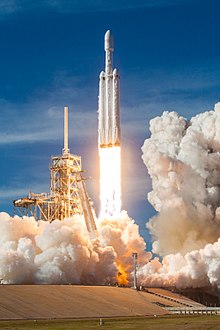
Back Falcon Heavy AN فالكون الثقيل Arabic Falcon Heavy AST Falcon Heavy Azerbaijani Фалкън Хеви Bulgarian ফ্যালকন হেভি Bengali/Bangla Falcon Heavy Catalan فاڵکۆن ھێڤی CKB Falcon Heavy Czech Falcon Heavy Welsh
 Falcon Heavy test flight launch | |
| Function | Super heavy-lift launch vehicle |
|---|---|
| Manufacturer | SpaceX |
| Country of origin | United States |
| Cost per launch | |
| Size | |
| Height | 70.0 m (229.6 ft)[3] |
| Diameter | 3.7 m (12 ft) (each booster) |
| Width | 12.2 m (40 ft) |
| Mass | 1,420,000 kg (3,130,000 lb) |
| Stages | 2.5 |
| Capacity | |
| Payload to LEO | |
| Orbital inclination | 28.5° |
| Mass |
|
| Payload to GTO | |
| Orbital inclination | 27.0° |
| Mass | 26,700 kg (58,900 lb)[3] |
| Payload to Mars | |
| Mass | 16,800 kg (37,000 lb)[3] |
| Payload to Pluto | |
| Mass | 3,500 kg (7,700 lb)[3] |
| Associated rockets | |
| Based on | Falcon 9 |
| Comparable | |
| Launch history | |
| Status | Active |
| Launch sites |
|
| Total launches | 11 |
| Success(es) | 11 |
| Landings |
|
| First flight | 6 February 2018 (test flight) |
| Type of passengers/cargo | |
| Boosters | |
| No. boosters | 2 |
| Powered by | 9 × Merlin 1D per booster[3] |
| Maximum thrust |
|
| Total thrust |
|
| Specific impulse | |
| Burn time | 154.3 seconds |
| Propellant | LOX / RP-1 |
| First stage | |
| Powered by | 9 × Merlin 1D[3] |
| Maximum thrust |
|
| Specific impulse |
|
| Burn time | 187 seconds |
| Propellant | LOX / RP-1 |
| Second stage | |
| Powered by | 1 × Merlin 1D Vacuum[3] |
| Maximum thrust | 934 kN (210,000 lbf) |
| Specific impulse | 348 s (3.41 km/s) |
| Burn time | 397 seconds |
| Propellant | LOX / RP-1 |
Falcon Heavy is a super heavy-lift launch vehicle[b] with partial reusability that can carry cargo into Earth orbit and beyond. It is designed, manufactured and launched by American aerospace company SpaceX.
The rocket consists of a center core on which two Falcon 9 boosters are attached, and a second stage on top of the center core.[6] Falcon Heavy has the second highest payload capacity of any currently operational launch vehicle behind NASA's Space Launch System (SLS), and the fourth-highest capacity of any rocket to reach orbit, trailing behind the SLS, Energia and the Saturn V.
SpaceX conducted Falcon Heavy's maiden launch on 6 February 2018, at 20:45 UTC.[7] As a dummy payload, the rocket carried a Tesla Roadster belonging to SpaceX founder Elon Musk, with a mannequin dubbed "Starman" in the driver's seat.[8] The second Falcon Heavy launch occurred on 11 April 2019, and all three booster rockets successfully returned to Earth.[9] The third Falcon Heavy launch successfully occurred on 25 June 2019. Since then, Falcon Heavy has been certified for the National Security Space Launch (NSSL) program.[10]
Falcon Heavy was designed to be able to carry humans into space beyond low Earth orbit, although as of February 2018[update], SpaceX does not intend to transport people on Falcon Heavy, nor pursue the human-rating certification process to transport NASA astronauts.[11] Both Falcon Heavy and Falcon 9 are expected to eventually be superseded by the Starship super-heavy lift launch vehicle, currently being developed.[12]
- ^ "Capabilities & Services" (PDF). SpaceX. 2022. Archived from the original (PDF) on 22 March 2022. Retrieved 22 March 2022.
- ^ Sheetz, Michael (12 February 2018). "Elon Musk says the new SpaceX Falcon Heavy rocket crushes its competition on cost". CNBC. Archived from the original on 3 July 2018. Retrieved 24 May 2018.
- ^ a b c d e f g h "Falcon Heavy". SpaceX. Archived from the original on 30 April 2023. Retrieved 22 April 2023.
- ^ "Falcon 9". SpaceX. 16 November 2012. Archived from the original on 1 May 2013. Retrieved 29 September 2013.
- ^ Ahmad, Taseer; Ammar, Ahmed; Kamara, Ahmed; Lim, Gabriel; Magowan, Caitlin; Todorova, Blaga; Tse, Yee Cheung; White, Tom. "The Mars Society Inspiration Mars International Student Design Competition" (PDF). Mars Society. Archived (PDF) from the original on 4 March 2016. Retrieved 24 October 2015.
- ^ Cite error: The named reference
sxf9o20100508was invoked but never defined (see the help page). - ^ Cite error: The named reference
cbs-harwoodwas invoked but never defined (see the help page). - ^ "Elon Musk's huge Falcon Heavy rocket set for launch". BBC News. 6 February 2018. Archived from the original on 6 February 2018. Retrieved 6 February 2018.
- ^ SpaceX (10 August 2018), Arabsat-6A Mission, archived from the original on 11 April 2019, retrieved 11 April 2019
- ^ Erwin, Sandra (21 September 2019). "Air Force certified Falcon Heavy for national security launch but more work needed to meet required orbits". SpaceNews. Archived from the original on 27 April 2021. Retrieved 22 September 2019.
- ^ Pasztor, Andy. "Elon Musk Says SpaceX's New Falcon Heavy Rocket Unlikely to Carry Astronauts". The Wall Street Journal. Archived from the original on 6 February 2018. Retrieved 6 February 2018.
- ^ Foust, Jeff (29 September 2017). "Musk unveils revised version of giant interplanetary launch system". SpaceNews. Archived from the original on 8 October 2017. Retrieved 3 May 2018.
Cite error: There are <ref group=lower-alpha> tags or {{efn}} templates on this page, but the references will not show without a {{reflist|group=lower-alpha}} template or {{notelist}} template (see the help page).